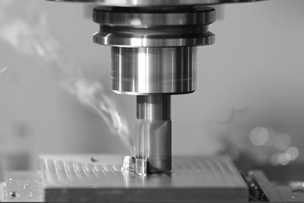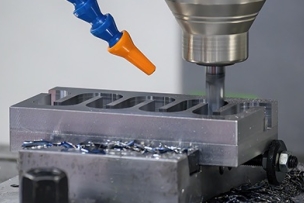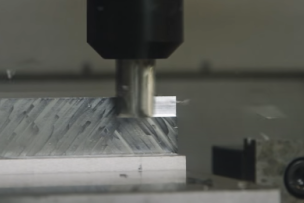The good news? CNC machinists have a lot to choose from when selecting an end mill. The bad news? CNC machinists have a lot to choose from when selecting an end mill.
Shopping for a milling cutter can be a confusing exercise. With dozens of brands and hundreds of geometries, sizes, flute counts, coatings, and substrates available, finding the best one often comes down to what you know or which company you trust most.
And while trust is a nice attribute to have in any relationship, relying on the “what you know” part of the preceding statement leads to lost opportunities.
Shops that stick solely to the tried-and-true miss out on the latest—and often greatest—advancements in cutting tool technology, a practice that can spell lower tool life and productivity. Sometimes, it spells the difference between profit and loss.
We’ll touch on details like material-specific carbide grades and variable helix geometries shortly, but let’s begin the topic of milling cutter selection by defining their three broad categories: solid, indexable and modular:
- Solid Carbide End Mills: As their name implies, solid end mills are ground from a single piece of material, usually cemented carbide, although high-speed steel (HSS) cobalt varieties are also available, as are solid ceramic tools for machining Inconel and other nickel-based heat-resistant superalloys (HRSA). Depending on your budget and application, solid carbide end mills begin the slide into cost-prohibitive territory somewhere in the ¾-inch to 1-inch diameter range, while HSS remains affordable (though less productive) up to a couple of inches or so.
- Indexable Cutters: Looking for a 6-inch diameter or larger end mill? If your machining center can drive it, they’re available, as are similarly humongous face mills, shell mills, button cutters, and a host of other indexable cutters. All are equipped with precision-ground carbide inserts that are attached to a steel cutter body using screws or sometimes clamps. Unlike most solid end mills, indexable cutters often boast coolant-through-the-tool capabilities and are far more cost-effective at larger sizes. As a rule, however, they are not center-cutting like many solid end mills (although it’s easy enough to ramp or helix cut in the Z-direction instead), nor are they as rigid (but still plenty strong for most applications).
- Modular Milling: Sometimes referred to as replaceable head milling cutters, modular end mills straddle the line between solid carbide’s performance and greater expense (particularly at the upper end of the size range) and the convenience of indexable tools. They use a single piece of carbide whose business end is identical to a solid end mill but has a proprietary threaded connection that screws onto a steel cutter body—and does so within seconds. Exceptions exist, but generally speaking, the sweet spot for these tools is in the ½-inch to 1½-inch range. And as with solid end mills, some modular heads can be reconditioned.
Workpiece Is Critical in End Mill Selection
So which one’s right for your application? It’s a great question, but it might be the wrong one to ask. Far more important than the milling tool’s cost or how it’s mounted are the workpiece material, shape, and tolerance; available spindle horsepower; machine rigidity; the number of parts to be machined; programming technique; and numerous other factors that help determine success during machining operations.
“For large indexable cutters especially, it’s critical to understand your machine’s horsepower and torque curves,” says Scott Etling, vice president of global product management at Kennametal. “You want to select a milling cutter with a diameter and number of inserts that allow you to utilize the full power of your machine tool—within the limits of your fixturing, of course—so as to maximize productivity for the application.”
Etling points to the company’s Dodeka series of indexable milling cutters as one way to achieve that. “It uses one insert that fits into three different pockets. So by changing cutter bodies, you could use a 75-degree lead angle and apply it as a high feed cutter; switch to a 30-degree for a heavier depth of cut; or go with a 45-degree lead angle as a happy medium between each of these.”
He laughs. “No one likes to hear it, but the answer with any cutting tool recommendation always comes down to something I heard long ago: It depends.”
Opposites Attract
Corey Schwenke is less concerned with horsepower draw, although he agrees with Etling as to the variables and complexity of cutting tool selection.
As the product manager for solid round tools at Sandvik Coromant—meaning he’s responsible for end mills, drills, reamers, taps, and exchangeable heads—Schwenke focuses practically all of his attention on the other (and generally smaller) end of the milling cutter spectrum: non-indexable cutting tools.
He’s quick to note that, with the exception of taps, high-speed steel is a non-starter at Sandvik Coromant, an increasingly common standpoint among cutting tool providers (Kennametal included), given carbide’s far greater tool life and productivity.
Schwenke also suggests that most shops do a good job when choosing between solid, modular and indexables. What they aren’t always so great at is choosing the correct grade, flute count and geometry for the task at hand.





Talk to Us!
Have become quite fond of modular. We do some deep pocketing and profiling in super-alloys. Due to increasing prices of larger diameter cutters, 5/8"Ø end mills have become our workhorses. Relying primarily on Helical Solutions long reach cutters with surprising rigidity and performance. It's nice that they can be sharpened once or twice but now there's nothing like being able to swap ends on a modular and keep going! You can even change profiles for different radii or chamfers. All the pluses of a solid and an indexable in one. Thanks for the article.
38This one comment sums up pretty much a CNC programmer job that can be the easiest or hardest part of programing the part.
“No one likes to hear it, but the answer with any cutting tool recommendation always comes down to something I heard long ago: It depends.”
Scott Etling
Kennametal
39While I do see the wisdom of trying new things in regards to cutting tools. I have identified the three most important factors as:
1. What is the most cost effective of work holding for the material or part so as to eliminate movement or chatter during machining processes.
2. The design, structural limitations and condition of the machines and equipment that holds and motivates the tool.
3. The capitol investment and return-on-investment in existing tooling.
When rationalizing on these 3 criteria, more often than not I say "no" to the latest greatest pitches and claims that tool salesmen make. I still am using HSS vanadium cobalt drills that out perform carbide drills in hard steel and they are paid for.
35Leave a reply
Your email address will not be published. Required fields are marked *